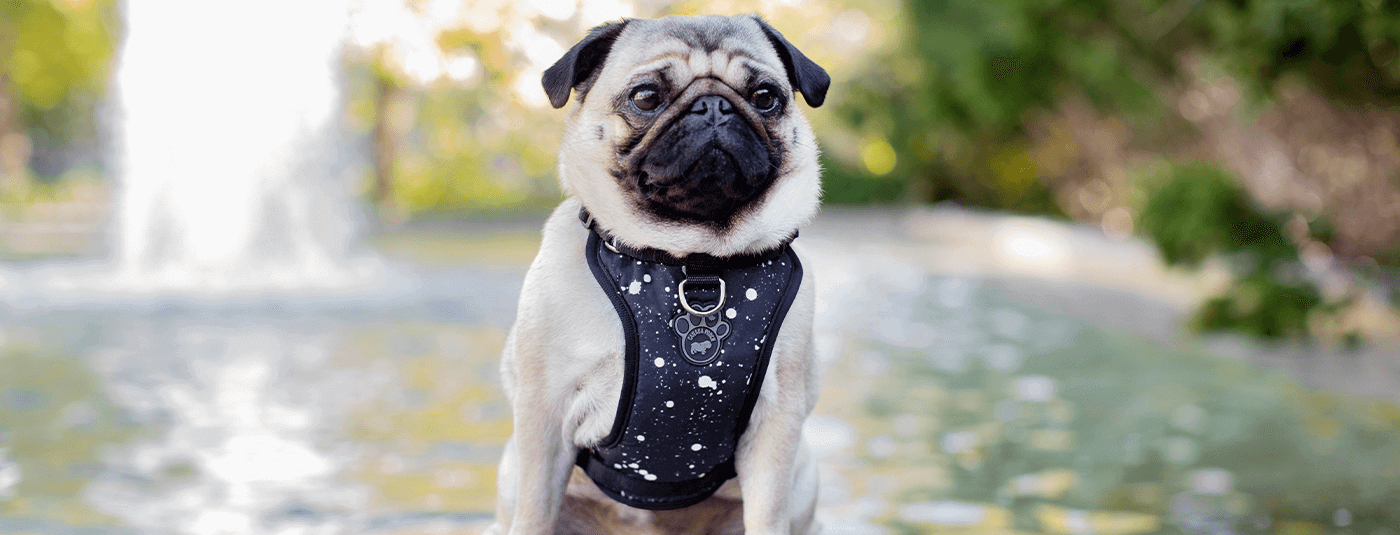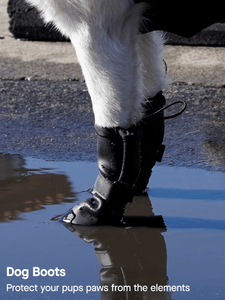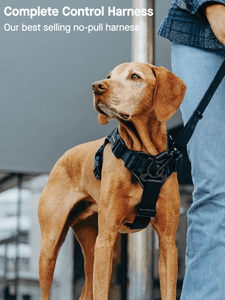Return to Blog
A Guide to Dog Harnesses: The Benefits and How to Fit Them
By Canada Pooch on Jul 11, 2022

There are many benefits to dog harnesses . Not only can they help deter dogs from pulling on the leash, but they will also reduce the strain on a dog’s trachea when pulling. Plus, when a harness fits correctly, it is less likely than a collar to slip off of your dog, making them a safe accessory for dog walks.
Most dogs will adapt quickly to wearing a harness as long as it doesn’t impede their range of motion, which is why it’s vital to fit a harness correctly!
If you’re considering adding a dog harness to your collection of dog walking gear, read on to learn which harnesses are best for each size of dog, how a harness can benefit your dog, how to fit a harness properly, and tips for putting on a dog harness for the first time!
Finding the Right Harness
When it comes to selecting a harness, it’s most important to consider the fit and the purpose. Some harnesses slip over a dog’s head while others are step-in harnesses. While both styles are perfectly effective, some dogs dislike having anything put on over their heads. If this applies to your dog, opt for a step-in harness.
If you’re looking for the best harness for a dog that pulls, look for a harness with a leash attachment point on the chest. Thanks to this attachment point, the dog will be automatically drawn to one side and directed back toward you when they strain against the leash.
Is it better to use a harness or a collar?
The fit of a harness also reduces the pressure on your pup’s throat and trachea, making it safer which is why many opt for a harness vs. a collar.
There are also considerations to make for the dog harness style depending on your dog’s size:
- The best harness for small dogs: Small dogs are more likely to trip or get tangled in their leash simply because they have shorter legs. A harness with a leash attachment on the back is a great way to prevent this!
- The best harness for large dogs: Because they weigh so much more than small dogs, it can be a considerable strain when your large dog pulls on the leash. Opt for a harness with a leash attachment on the chest to reduce pulling and make it easier to control your large dog.
Canada Pooch’s Everything Harness is a fantastic option for dogs of all sizes. It has a breathable mesh exterior, a no-pull D-ring leash attachment on the chest and an additional attachment loop between the shoulders. It also features a seat belt loop and a sturdy handle on the back, making it easy to lift or assist your dog when getting in and out of the car.
The Everything Harness comes in five colorways, four different sizes, and can be easily adjusted around the neck and girth to suit any body type. Additionally, the harness buckles around your dog, so there’s no need to slip it over your pup’s head.
How should a dog harness fit?
Ensuring a dog harness fits correctly is essential for both comfort and function. If the harness is too tight, it may be uncomfortable for your pup. But, if it’s too loose, it could impede your dog’s range of motion or slip off. Follow these guidelines to learn how tight your dog’s harness should be and where it should sit on your dog.
Use a soft measuring tape to measure your dog’s neck and the widest point of their rib cage. These measurements will help you determine what size of harness to purchase.
Once you have the harness, adjust the straps to your dog’s unique fit. It should be snug but not tight. If your dog’s skin is bulging around the straps of the harness, it’s probably too tight. If the harness slips out of place when your dog walks, it’s too loose. The harness should not impede your dog’s range of motion, and there should not be any gaps between the straps and your dog’s body. The back of the harness should sit between your dog’s shoulders, and the girth strap should sit behind the elbows but not behind the rib cage.
It may take a few tries to find the right fit for your dog. The harness may look secure but then slip out of place when your dog starts running around. If so, tighten the straps slightly and try again.
How to put on a dog harness
The process for putting on a dog harness for the first time is very similar to helping your dog adjust to wearing clothes.
First, let your dog sniff and inspect the harness before putting it on. Then, praise your dog as you begin putting the harness on. It may be easiest to leave the harness loose at first so your dog can adjust to the idea before tightening it to fit correctly. Use lots of treats and positive reinforcement throughout the entire process.
As long as your dog tolerates it, adjust the fit of the harness and let them wear it for a few minutes. Again, use rewards to comfort them during this new experience. Many dogs won’t mind wearing a harness at all, but some may need extra encouragement. If your dog is resistant, take it off after a few minutes and try again later. They may need to work up to wearing it for longer intervals.
A harness is an invaluable tool for walking your dog safely and comfortably. But, to be truly effective, the harness needs to fit correctly . An ill-fitting harness will be uncomfortable for your dog and could even slip off or trip your pup. Have your pup wear their new harness around the house for a bit so you can ensure it fits correctly before heading out on a walk.


